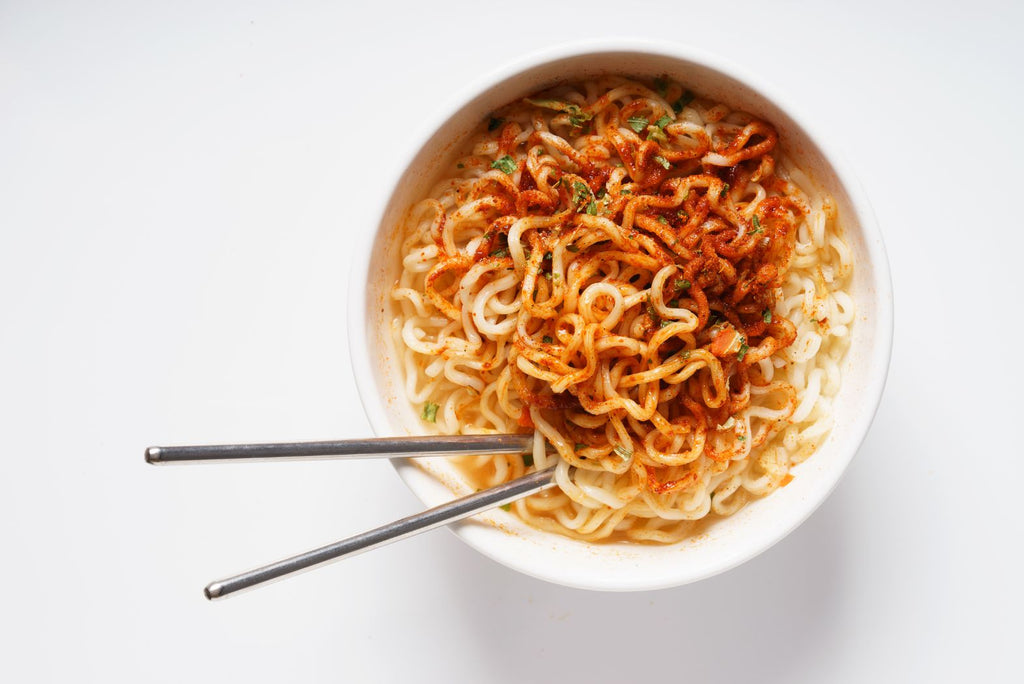The History of Japanese Instant Noodles: A Deep Dive
By Jannika Resido
-
April 17th, 2024

Exploring the world of Japanese instant noodles reveals a tapestry of history, innovation, and flavour. From humble beginnings to widespread global popularity - Japanese instant noodles have become a staple of quick, delicious meals.
In this blog, we'll dive into the origins, evolution, and cultural significance of Japanese instant noodles.
Introduction to Japanese instant noodles
The birth of instant noodles
The story of Japanese instant noodles begins in the post-war era, a time when Japan was grappling with food shortages. It was then that Momofuku Ando, a Taiwanese-Japanese inventor, took on the challenge of creating a quick and easy food solution.
In 1958, he succeeded, unveiling the world's first instant noodles: Chicken Ramen. This pioneering product, which could be prepared in mere minutes by adding hot water, revolutionized the way people consumed food.
It represented comfort, convenience, and a new hope for a country rebuilding itself. The success of Chicken Ramen noodles laid the groundwork for a new food industry that would eventually travel the globe.
The role of instant noodles in Japanese culture
Instant noodles have a prominent place in Japanese culture. They have become a cultural icon. Universally recognized as a quick meal fix, they also hold a special significance in the lives of busy workers and students looking for an affordable and simple meal.
They have also inspired a huge amount of flavour creativity and innovation, with limited-edition flavours and collaborations a common phenomenon. Some of the instant ramen noodle flavours we've seen can range from 'olive oil and salt' to 'bagna cauda' (an Italian anchovy and garlic dip), Thai soup flavours - and we've even rumours of a chocolate instant ramen!
Instant noodles are not just an economic choice; they are a canvas for experimentation. Instant noodles have served as a symbol of Japan's post-war resurgence and technological advancement.
The evolution of Japanese instant noodles
The era of chicken ramen
Momofuku Ando's invention, Chicken Ramen, marked the beginning of the era of instant noodles. Dubbed as 'magic ramen' due to its convenience and taste, Chicken Ramen became an instant hit.
It signified a new age of food production and consumption in Japan. In a time when preparing traditional ramen was time-consuming, Chicken Ramen offered a significant time-saving alternative.
Chicken Ramen sparked curiosity and interest worldwide, paving the way for global recognition...

The emergence of cup noodles
In 1971, the landscape of instant noodles underwent another revolution with the emergence of Cup Noodles, a brand of instant noodles manufactured by Nissin. These cups were sealed in a new convenient way, and appealed to a new generation.
Cup Noodles' innovative packaging also allowed for an array of flavours and textures, including freeze-dried vegetables and meat, cementing its position as a beloved and practical meal choice worldwide. Its success solidified Japan's reputation as an innovator in the food industry.
The company began by handing out samples in Tokyo's busy pedestrianised area of Ginza. These sampling sale events were a huge hit, and the company recollects handing out as many as 20,000 pots of Cup Noodles a day.
And of course the influence of Cup Noodles has been seen across the world - with brands such as Pot Noodles quickly following in their footsteps.
In 1973 Nissin launched Cup Noodles in America, with three signature flavours: prawn, chicken and beef. Each pot also included dehydrated egg too.
Famous brands of Japanese instant noodles
Nissin Foods
Nissin Foods is synonymous with the rise of Japanese instant noodles, having a pivotal role in this industry since its inception. Founded by Momofuku Ando, the inventor of instant noodles himself, Nissin Foods has been instrumental in introducing innovative products and services that have shaped consumer habits.
Nissin's commitment to innovation is evident in its constant expansion of flavour varieties and product lines that cater to evolving consumer tastes.
The company also plays a significant role in globalising Japanese instant noodles, ensuring that this staple of Japanese cuisine has found its way into kitchens around the world. Nissin Foods remains a dominant force in the market, continually pushing the boundaries of what instant noodles can be.
Maruchan
Maruchan is another leading name in the world of Japanese instant noodles, with an extensive range of products that have become a staple in many households. Established in 1953, as a company selling frozen fish, Maruchan started making instant noodles in 1961.
Known for its variety of flavours and styles of noodle dish, Maruchan makes traditional ramen, udon, and yakisoba noodles. Their products are characterised by rich broths and ingredients, aiming to replicate the experience of dining in a Japanese noodle shop.
Maruchan's ability to balance tradition with convenience has helped them secure a loyal customer base. With facilities now in several countries, Maruchan has successfully brought Japanese instant noodles to an international audience, contributing to the global appreciation of these quick and delicious meals.

The manufacturing process behind Japanese instant noodles
The ingredients and method
The manufacturing process of Japanese instant noodles is meticulous. The choice of ingredients and preparation is crucial to the flavour of the final product. Instant noodles are typically made from wheat flour, water, and salt, and sometimes include kansui, an alkaline mix that gives them their characteristic texture and flavour.
The mixture is kneaded, rolled out, and then cut into strands. Unsurprisingly, the key to transforming fresh noodles into instant ones is the dehydration process. This is typically done through frying or air-drying. Frying the noodles removes moisture quickly, creating a porous structure that allows for rapid rehydration.
Alternatively, air-drying, which is a slower process, and often results in a firmer noodle texture.
Small seasoning packets usually accompany the noodles, containing a blend of spices, freeze-dried vegetables, and occasionally, powdered meats or seafood, which all contribute to the authentic taste of Japanese instant noodles.
Packaging and preservation
Once the Japanese instant noodles are prepared, they move on to the critical stages of packaging and preservation. The packaging is designed to protect the noodles and ensure they remain fresh. And of course it's the packaging that sets pot noodles, or noodle cups apart from other instant noodles.
Packing Japanese instant noodles typically involves airtight plastic or foil wrappers, which are crucial for preventing moisture and air from entering and spoiling the product. To enhance shelf life, manufacturers often include oxygen absorbers in the packaging, which helps to prevent oxidation and maintain the quality of the noodles over time.
Japanase instant noodle packaging is often bright, bold and attention-grabbing.
Impact and popularity of Japanese instant noodles globally
Japanese instant noodles in the UK
Japanese instant noodles have made a significant impact on the UK food market. And reflect the global trend of increased interest in Asian cuisine. In Britain, Japanese instant noodles have found a place in the cupboards of many homes.
Today, supermarkets and Asian speciality stores across the whole country now stock a huge variety of brands and flavours, catering to a growing consumer base that includes students, professionals, and anyone seeking a fast and tasty meal.
The popularity of Japanese instant noodles in the UK also points to a broader interest in and enjoyment of Japanese culture. Instant noodle dishes becoming a comfort food for many in a country well-known for its love of quick and hearty meals.
The culinary influence of instant noodles
The global impact of Japanese instant noodles extends far beyond simple convenience. They have influenced cooking habits and sparked a wave of innovation in home cooking. Around the world, people have embraced these noodles, incorporating them into traditional dishes or creating new fusion meals.
The versatility of instant noodles makes them a canvas for creativity, allowing anyone from professional chefs to college students to experiment with flavours and ingredients. This culinary influence has led to the creation of unique recipes and even food challenges that celebrate the adaptability of Japanese instant noodles.
TikTok and Instagram are awash with people using Japanese instant noodles in imaginative ways. Here are a few of the most fun, imaginative, and delicious ways we've seen them being used:
-
Burger 'buns' made from two round instant noodle blocks - cooked and hydrated, then deep fried into shape
-
Instant noodles crushed into powder, then mixed into mashed potato to form 'gnocchi'.
-
Wrapping cooked instant noodles around king prawns then deep-frying
-
Incorporating instant noodles into beaten egg, before cooking as a frittata.
The list of exciting ways to use Japanese instant noodles is seemingly endless...!
The phenomenon of customizing instant noodle dishes has also encouraged a deeper exploration of Japanese cuisine, leading to a better understanding and appreciation of its complexities and nuances. As a result, Japanese instant noodles have not only become a staple food item but also a symbol of cultural exchange and gastronomic innovation.

About the author
Jannika Resido is Sous Chef's online content specialist. She is an expert in southeast Asian food and ingredients! Jannika has several years of experience writing blogs and features for online publications. She loves trying new ingredients, and discovering recipes from across the world.


